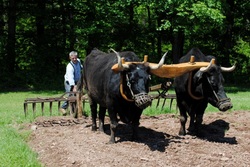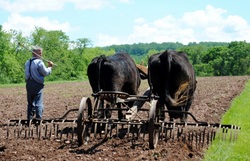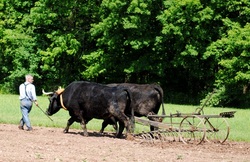Farmer Rob's objective was to eliminate the very nice-looking crop of weeds growing in with the potatoes. To do the job, he used a mechanical weeder similar to ones used during Howell Farm's circa-1900 time period. The weeder is designed to kill emerging weeds without disturbing the slightly larger, better established crop planted by the farmer. To do this, the implement must be adjusted carefully ... and the stage of crop vs. weed development must be properly assessed. And, not only do crops have to be ahead of weeds, but the timing of weeding has to be just right: it must be hot enough that weeds knocked over by the weeder die as their roots are scorched by the sun and don't have a chance to re-set.
The photos below were by taken by Margie Lucido of Hamilton, who captured these images while visiting with her family on Saturday.
Rob sets the weeder depth so that tines work just the uppermost layer of soil, where weeds are just beginning to emerge. If the weeds are allowed to grow along with the potatoes, they will reduce the water, nutrients and light available to the cultivated crop, reducing the yield.
After traveling forward several feet, Rob stops the oxen so he can check the effectiveness of the weeding action and, if necessary, fine tune the adjustment of the weeder.
It took Rob about 30 minutes to weed the 2/3 acre field. Subsequent weeding operations will not be done with the weeder, but with a cultivator that will weed between the rows. During the second or third cultivation, equipment will be used that "hills" the potatoes by pushing soil up against the rows. The operation adds a layer of soil to the row that will help keep the potatoes covered; it also buries weeds that are growing between the plants that form the row.



 RSS Feed
RSS Feed
